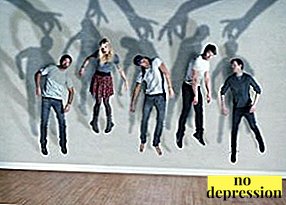Imagination - complex mental processinherent only to man and consisting in the creation of new images on the basis of the experience experienced by man.
What is it and what are its features and functions for a person?
Active

Active, otherwise called deliberate, imagination is conscious work of a person with the creation of new images.
This is done intentional work with the transformation of any information to implement a well-defined goal.
Person does not lose touch with reality, does not lose temporary connections, but, using his accumulated experience, seeks to get a certain result, which at the initial moment of time is not yet known to him.
Also, as a rule, he does not know exactly when and on what will stop this creative process until he gets a result satisfying his needs.
Kinds
Active imagination is represented by the following subspecies:
- Recreative. Also called reproductive.
In this case, the person constructs new images, based on information transmitted to him from outside.
This may be a verbal message, symbols, schematic plans, a description of the area, etc.
- Creative or productive. This type is closely related to memory. It is used in situations where, on the basis of the experience gained, a person needs to create a product of mental activity that has no analogues before, which is not previously encountered - that is, create a fundamentally new image.
- Anticipatory. It goes back to the adaptive mechanisms of the brain. His ultimate goal is anticipation of the future on the basis of the information currently available. It is also directly related to the instinct of human self-preservation. Thanks to him, a person can plan certain steps towards a goal, foresee the consequences of his actions. Compliance with the information predicted by the imagination directly depends on the person’s experience in a given situation, on the completeness of the information provided and other factors.
- Dream. This species is often regarded as separate. A dream is the creation of images of the desired future. At the same time, a dream can be viewed as a strategic direction, the definition of a person’s goal in life.
However, a distinctive feature of the dream is the uncertainty of steps towards its realization.

Examples
Recreative
It is easy to illustrate it in the following situation - a person who is on a particular location for the first time is explained how to get to the required point. Accordingly, he has to with the help of imagination recreate an approximate picture of the area.

Also a rather vivid example of it is creating images when reading fiction - the appearance of the characters, descriptions of the scene, etc.
In practice, recreating imagination is included when using schematic plans, instructions, algorithms to the execution of an action.
Creative (productive)
Composers, artists, writers in the course of their activities resort to the use of productive imagination. They do not just convey, copy reality, but create fundamentally new images and their combinations.
It is also impossible to imagine the work of scientists without creative imagination. The elaboration of theories and hypotheses requires fundamentally new approaches, views on things we are used to, the creation of absolutely new concepts.
Great value creative imagination plays in design workwhere it is often necessary to change various technical specifications in such a case when all known approaches do not give the desired result.
Anticipatory

An example might be man's fear of walking on the edge of the roof a high-rise building, when negative images of a fall are created in a person's mind - as a result of an inaccurate step, dizziness.
At the same time, there are pictures of possible injuries, pain associated with them, and even fear of death.
As a result, the person refuses the dangerous walk that could potentially save his life.
However, the anticipating imagination is manifested not only in extreme situations. Its most important function is anticipate the immediate future.
Person “tries on” the consequences in advance this or that action which he can make and in accordance with his ideas chooses the most acceptable option for him.
At the same time, situations often arise in which a person does not have enough own experience to make the right decision, in his opinion. At such moments, the anticipating imagination turns on.
Dream

With the help of a dream, a person builds his ultimate life goal, without going into details of the steps for its implementation.
Nevertheless, a dream can be considered as a kind of strategic direction in activity, as a path to striving.
For example, a man dreams of creating a family, buying a house and a car, however does not know when and how this will happen.
However, he seeks to improve his career, to earn a home and a car, trying to find a girl who would cause him sincere interest - in this case it can be called dream plan. It has a conscious nature, setting the direction of all activities.
In some cases, the dream is defensive psychological in nature, being a substitute for real activity.
At the same time, a person, instead of taking real steps to achieve a goal, more and more plunges into dreams, having no idea how he will implement themthus departing from reality.
Passive

By passive (involuntary) imagination is meant such the appearance of images that does not require conscious effort from a person.
With a weakened conscious control, they arise by themselves, without the willpower of a person.
AT the source of their occurrence there is no logical connection and awareness of reality by a person.
The arising passive images often serve as a reflection of his internal state, fears, aspirations, desires, speak of the personal needs of the individual.
Involuntary imagination is often not subjected to logical reflection, often representing a combination of completely contradictory images.
It is also often the complexity of his verbalization after experiencing, since such images are often symbolic, abstract and incomprehensible to other people.
Managed passive imagination by two basic principles:
- Every affect seeks to preserve, exaggerating the subjective logical value of representations. Thus, a cheerful person will often have positive images, and a sad person will, on the contrary, be sad.
- Man seeks keep pleasant experiences, and, hence, pleasant arisen images.
Often passively arisen images are not tied to time. Thus, the person watching them also loses sense of time.
Subspecies

Passive imagination is divided into two subspecies:
- unintentional. Includes hallucinations, dreams and dreams. Arise by themselves, without the will of a person;
- intentional - hypnotic states caused by another person.
Description
- Dreams. On a scale of arbitrariness, they occupy the most distant position of awareness. Often in dreams, we are bizarre images and strange scenes.
Nevertheless, they are important for the regulation of the psycho-emotional state of a person, as they are not only echoes of what he had heard and seen before, but also represent a very deeply processed psyche material.
- Dreams. Dreams, like dreams, are often a departure from reality with the difference that dreams are directed to the future, and dreams replace the present. For example, a schoolboy, offended by his comrades, can imagine how he takes revenge on offenders. In this case, the emerging images will be an alternative reality, bringing some satisfaction to the student, but at the same time taking him away from the real state of affairs.
- Hypnotic condition. The deeper the hypnotic trance, the less attention a person gives to external stimuli, the less true reality means to him. The subjective sense of time can also change, negative hallucinations occur when a person does not see real objects. Only the connection with the hypnotist who induces trance is preserved. Hypnotic trance is often used in psychotherapy.
- Hallucinations Hallucinations usually occur in people with congenital physiological brain damage, as a result of traumatic brain injury, viral infections, and psychotropic substances. Often perceived as a true reality.

How interrelated and how are they distinguished?
The main difference between active and passive imagination is that when the former is used for the emergence of images, the will of a person is used, they are controlled by conscious activity. In the second case, the appearance of images is spontaneous, it is not controlled by consciousness.
The general nature of active and passive imagination is clearly seen in the example of preschool children. In the early preschool years it's hard for children to control their imagination.

For this reason, they can play role-playing games for no more than 10-15 minutes, distracting themselves with external stimuli.
With time image control is enhanced, children longer remain involved in one story game, learning to control their ideas and fantasies.
Active and passive imagination play an important role in human activities, providing emotional balance, allowing you to perform creative tasks, plan actions and navigate in unusual situations, opening up opportunities for new experience.
You can learn about active and passive imagination from this video:



